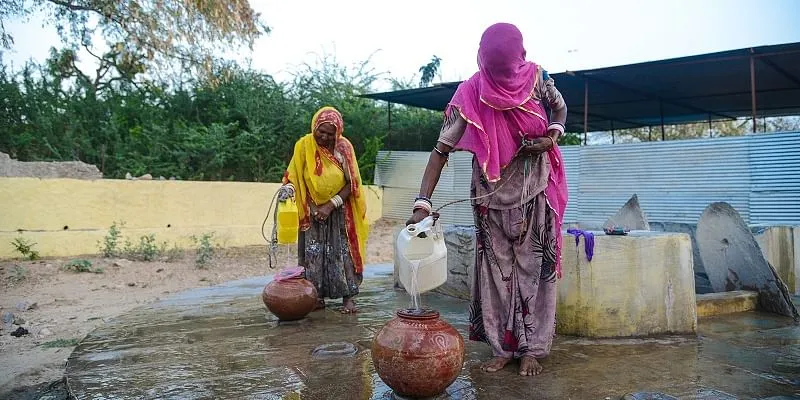Harvesting rain, the key to turning rural India’s water woes around
The simple act of capturing rain as and when it falls is a significant step towards tackling water scarcity in India, particularly in hard-hit rural areas.
As people lament about the looming water crisis that India faces, it is easy to believe that we need a ‘miracle’ to turn things around. But the truth of the matter is that many effective solutions exist, if only we would focus our efforts, roll up our sleeves, and get to work.
While there is certainly a need to examine how we are ‘using’ this precious resource and adopt more judicious water practices, the simple act of capturing rain as and when it falls is a significant step towards tackling water scarcity in India, particularly in hard-hit rural areas.

The involvement of community members in Rajasthan helped revive the community pond.
Reviving traditional systems
In fact, many answers lie in reviving and embracing the traditional water harvesting systems that are unique to each part of the country. Indians have had a rich history of managing water. Our forefathers harnessed water that fell during the rainy season and stored it to meet the needs of the community during the remaining dry months of the year. To do this, they used ‘traditional water harvesting systems’—a diverse range of structures that helped harvest rainwater when and where it fell and store it–replenishing and recharging the groundwater along the way.
Every region in the country has its own traditional water harvesting systems that are unique to the geography and culture of the area. Bamboo pipes and apatani systems (water harvesting system) are used in the Eastern Himalayas, while ghul (traditional irrigation systems) is used in the Western Himalayas. Kund (a traditional rainwater harvesting structure), khadin (a structure to harvest surface run-off), talabs (ponds), johad (percolation pond), and baoli (stepwell) are harnessed in the Thar desert and Gujarat. While in Bihar, ahar-pynes (traditional floodwater-harvesting systems) are used. The list goes on.
Back then, the belief was that water was a communal resource to be managed by the community for the wellbeing of everyone. However, during the colonisation of India, the British replaced this dispersed, decentralised system for the management of water with a centralised one, whereby the Public Works Department took control of the precious resource. As a result, people gave up the responsibility of managing and caring for water and instead saw it as a resource that was ‘doled out by the powers that be.’
But these incredible structures still exist and many simply lie in disuse, in need of restoration and repair. They can be revived to their former glory. But it takes work. People must be mobilised, organised, and empowered with the knowledge that their ancestors once had—on how to manage these structures and the water they collect, equitably, to ensure water sustainability for all. This is where NGOs and civil society can play role to enable people to take back control of their water.
Rooftop rainwater harvesting systems
Another simple but effective mechanism is the humble rooftop rainwater harvesting system. Once a traditional method of harvesting water in western Rajasthan, the rainwater harvesting system has evolved today to provide a low-cost, long-term solution for homes and families to gain access to water supply for domestic purposes all year round.

It is a simple structure that collects and stores rainwater, directly from household rooftops, for immediate or future use. When installed in one house, it can save approximately 1,00,000 litres of water every year—sufficient to meet the needs of a family of 4-5 members by providing a year’s supply of water. This can be a gamechanger for households where domestic water scarcity adversely affects water consumption, hygiene, and ultimately health—with an overall impact on livelihoods.
Summing up
India’s huge and growing population and inefficient agricultural practices are putting a severe strain on the country’s natural resources, in particular water, which is the most vulnerable resource. Water is life to all living beings and the driving force behind sustaining civilisation.
While climate change is impacting the reliability of monsoon rains, we as a country are blessed with heavy rainfall during those critical months of the year. As a first step, every one of us needs to capture that rain, as and when it falls, and store it, thus using it to support our domestic water needs for the remainder of the year. By doing so, we would ease the incredible strain on existing resources and perpetually push back the ‘doomsday’ that every community would face—the day we literally run out of water.
Edited by Swetha Kannan
(Disclaimer: The views and opinions expressed in this article are those of the author and do not necessarily reflect the views of YourStory.)







